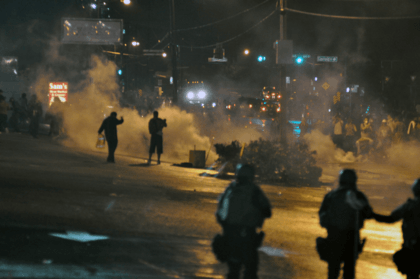Ferguson unrest facts for kids
Quick facts for kids Ferguson unrest |
|
|---|---|
| Part of the Black Lives Matter movement and reactions to the Killing of Michael Brown |
|

Police officers using tear gas on protesters
|
|
| Date | First wave: August 9–25, 2014 Second wave: November 24 – December 2, 2014}} Third wave: August 9–11, 2015 |
| Location |
Ferguson, Missouri, U.S. and St. Louis, Missouri, U.S.
|
| Caused by | First wave: Killing of Michael Brown Second wave: Darren Wilson not indicted Third wave: Anniversary of shooting |
| Methods | Widespread rioting, vandalism, looting, arson, and gunfire. |
| Casualties | |
| Injuries | 10 members of the public injured 6 police officers injured |
| Arrested | 321 members of the public |
The Ferguson unrest was a series of protests and riots that started in Ferguson, Missouri, on August 10, 2014. This happened the day after Michael Brown, an 18-year-old, was shot by a police officer named Darren Wilson. These events led to big discussions across the United States. People talked about how police officers interact with Black Americans, how police forces sometimes look like armies, and rules about when police can use force. Later, people also protested about other issues, like unfair court fines that trap people in debt, police departments focusing on making money, and schools being separated by race.
As more details about the shooting came out, police set up curfews and sent in special riot teams. Along with peaceful protests, there was also a lot of looting and violence near where the shooting happened, and across the city. The unrest continued on November 24, 2014, after a group of citizens decided not to bring charges against Officer Wilson. The protests briefly started again on the first anniversary of Brown's shooting. The Department of Justice (DOJ) later said that Officer Wilson shot Brown to protect himself.
Because of the shooting and the protests, the Department of Justice looked into how the Ferguson Police Department (FPD) was doing its job. In March 2015, the DOJ announced that the FPD had treated people unfairly. They found that the police department discriminated against African Americans and used racial stereotypes. The DOJ also found that the Ferguson city government relied on money from fines and other charges given out by the police to pay for city services.
What Caused the Ferguson Unrest?
Michael Brown, an 18-year-old African-American, was killed during an encounter with Officer Darren Wilson. Officer Wilson arrived after a report of a theft at a nearby store. The person who called described the suspect, who was later identified as Michael Brown from security cameras.
Officer Wilson said that he saw Brown and his friend walking in the middle of the street and asked them to move to the sidewalk. When they refused, Wilson noticed that Brown's shirt and a box of cigarillos he was holding matched the description from the theft call. He suspected Brown and his friend were involved.
When Officer Wilson tried to question Michael Brown, he said Brown attacked him. There was a struggle, and Brown tried to grab Officer Wilson's gun. During the struggle, the gun fired, slightly hurting Brown, who then ran away. Wilson chased Brown and fired his weapon. Wilson said Brown turned to face him and charged at him, which led to Wilson shooting Brown again, killing him. Officer Wilson was a 28-year-old white police officer from Ferguson.
After several months, a group of citizens decided not to bring any criminal charges against Officer Wilson for the incident. Many people criticized how the police handled the shooting and how slowly information was shared with the public. Many documents reviewed by the group of citizens were released when they decided not to bring charges against Officer Wilson.
Images for kids
-
St. Charles County SWAT team at Ferguson. The device on top of the armored vehicle is a type of directed-energy weapon called an LRAD







